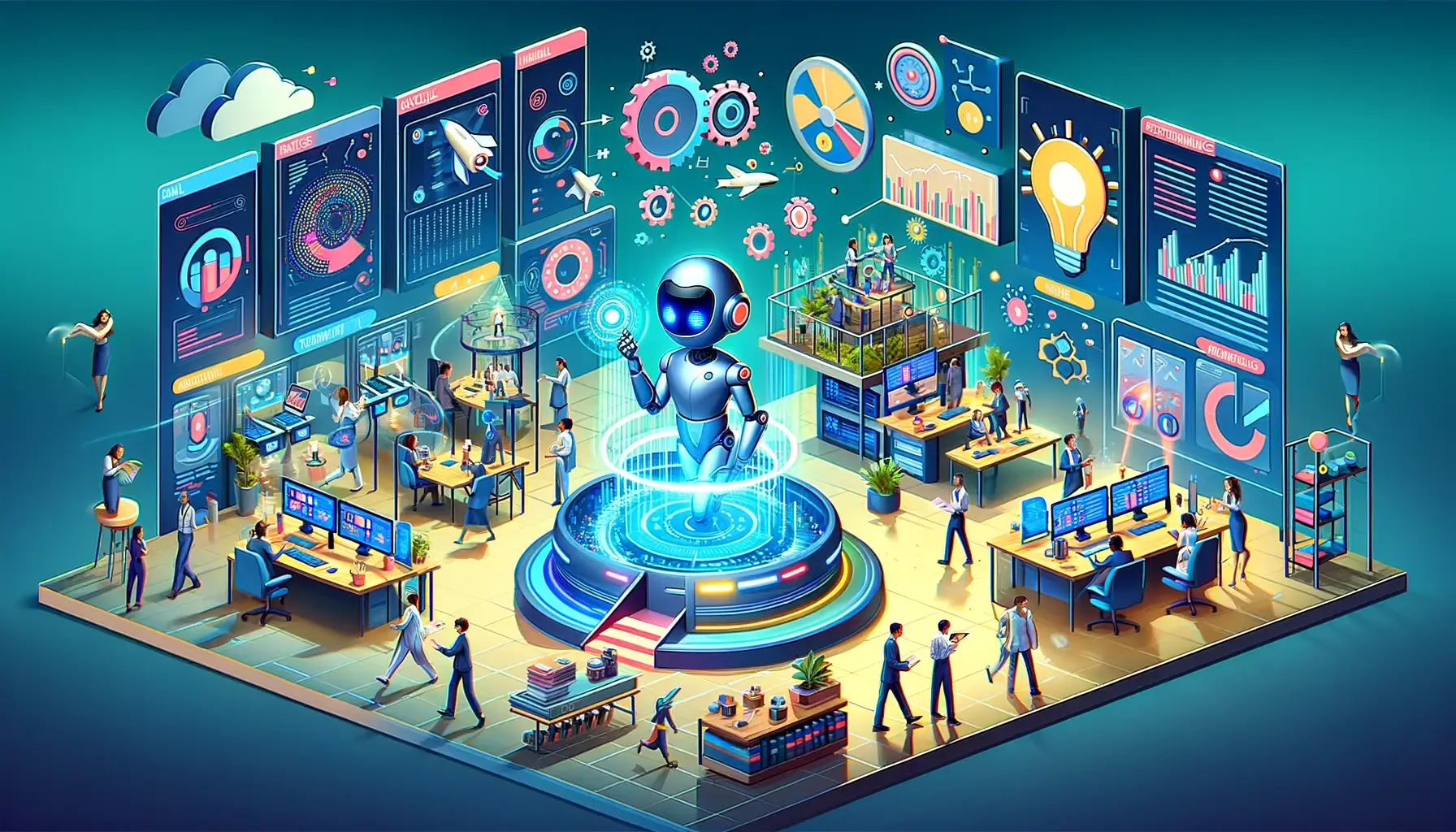The Future of Workforce Optimization: How AI Transforms Employee Efficiency

Introduction
In today's rapidly evolving business landscape, the quest for maximum efficiency and productivity is relentless. Workforce optimization, traditionally a balance of scheduling, training, and performance monitoring, is undergoing a revolutionary change, thanks to Artificial Intelligence (AI). As businesses seek to enhance operations and boost employee efficiency, AI emerges as a transformative force. This article delves into how AI is reshaping workforce optimization, promising not only heightened efficiency but also improved employee satisfaction and business agility. Let's explore the future of workforce optimization and how AI is making workplaces more dynamic and efficient than ever before.
Understanding Workforce Optimization
Definition and Importance of Workforce Optimization
Workforce optimization refers to the strategies and tools used by businesses to improve employee performance and operational efficiency. It encompasses everything from scheduling and task allocation to performance monitoring and training. Effective workforce optimization ensures the right employees are performing the right tasks at the right time, leading to improved customer service, higher employee satisfaction, and increased profitability.
Traditional Methods vs. The Need for Innovation
Traditionally, workforce optimization has relied heavily on human planning and intuition, supported by basic software tools for scheduling and monitoring. However, as businesses grow and become more complex, these traditional methods are increasingly inadequate. They are often time-consuming, prone to error, and lack the agility needed in today's fast-paced environment. This has led to a growing need for innovation in how companies approach workforce optimization.
The Impact of Inefficient Workforce Management on Businesses
Inefficient workforce management can lead to numerous problems, including poor customer service, low employee morale, high turnover rates, and ultimately, reduced profitability. When employees are mismatched with tasks, overburdened, or poorly scheduled, both the business and its customers suffer. As such, optimizing the workforce is not just a matter of efficiency; it's a critical component of a company's success and competitiveness.
The Advent of AI in Workforce Management
Introduction to AI and Its Relevance to Workforce Optimization
AI refers to the simulation of human intelligence in machines that are programmed to think and learn. In the context of workforce optimization, AI can analyze large volumes of data, predict trends, and make decisions, often in real time. This capability is incredibly relevant to workforce optimization, as it can significantly enhance decision-making, forecasting, and the overall management of employees.
Overview of AI Technologies Being Used
Several AI technologies are being used to revolutionize workforce optimization. Machine Learning algorithms can predict optimal staffing levels, while Natural Language Processing (NLP) allows for better communication and feedback collection from employees. Other technologies like predictive analytics can forecast future staffing needs based on patterns and trends.
How AI is Currently Being Implemented in Various Industries for Workforce Management
AI is being adopted across various industries to address unique workforce challenges. In retail, AI is used for dynamic scheduling, adjusting staff levels to match customer traffic patterns. In healthcare, it helps manage shift rotations and patient care needs. Manufacturing industries use AI for safety monitoring and predictive maintenance scheduling, ensuring that workforce tasks are aligned with equipment availability and production needs.
This introduction and the first two sections set the stage for a comprehensive exploration of how AI is transforming workforce optimization, providing a clear understanding of the traditional landscape and introducing the innovative potential of AI. The following sections will continue to delve deeper into the specific benefits, applications, and considerations of integrating AI into workforce management strategies.
Transformative Effects of AI on Employee Efficiency
Detailed Examples of AI Applications in Scheduling, Task Management, and Performance Analysis
AI revolutionizes scheduling by predicting peak hours and aligning staff strength accordingly, ensuring businesses are never under or overstaffed. In task management, AI helps in assigning tasks based on employees' skills and track records, thereby increasing productivity and job satisfaction. For performance analysis, AI tools provide real-time feedback and actionable insights, allowing for immediate adjustments and personalized development plans.
Case Studies of Companies Successfully Integrating AI into Their Workforce Management
Consider a retail giant that implemented AI for scheduling and reduced understaffing during peak hours by 20%, significantly improving customer service and sales. Another example is a healthcare provider that used AI to manage staff rotations, leading to a 30% reduction in burnout rates and improved patient care. These case studies exemplify the tangible benefits AI brings to workforce optimization.
The Benefits Realized: Increased Productivity, Better Resource Allocation, and Enhanced Job Satisfaction
AI's predictive capabilities ensure optimal resource allocation, leading to significant cost savings and productivity boosts. By automating routine tasks, employees can focus on more strategic and fulfilling work, leading to enhanced job satisfaction. Moreover, AI-driven workforce optimization contributes to a more agile business that can quickly adapt to changing market demands.
AI and Employee Experience
How AI Contributes to a Better Understanding of Employee Needs and Preferences
AI tools can analyze employee feedback, performance data, and engagement levels to provide insights into what employees value and need. This understanding allows managers to create a more supportive and motivating work environment, tailor training programs, and address issues proactively.
The Role of AI in Fostering a Positive Work Environment and Culture
AI-driven workforce optimization helps in recognizing and rewarding high performers, promoting a culture of excellence and fairness. It also aids in identifying and addressing workplace issues early, contributing to a positive and inclusive culture.
Addressing Concerns: Ensuring AI Implementations Consider Employee Well-being and Job Security
While AI brings numerous benefits, it's crucial to address concerns around job displacement and privacy. Companies should focus on using AI as a tool to augment human capabilities, not replace them. Transparent communication about AI's role, ethical AI practices, and continuous upskilling of employees are key to ensuring a positive transition.
Overcoming Challenges and Setting Up for Success
Common Challenges Businesses Face When Integrating AI into Workforce Management
Challenges include data privacy concerns, resistance to change from employees, and the need for significant upfront investment. Additionally, ensuring the quality and relevance of data fed into AI systems is crucial for effective outcomes.
Strategies for Successful Implementation: Training, Change Management, and Choosing the Right Tools
Successful AI integration involves comprehensive training for employees, an effective change management strategy to address resistance, and choosing the right AI tools that align with business objectives and workforce needs. Continuous evaluation and adaptation are also vital as businesses and technologies evolve.
Future Trends: What to Expect in AI for Workforce Optimization
Future trends may include more sophisticated AI that can handle increasingly complex tasks, greater personalization in employee management, and more seamless integration of AI in day-to-day operations. The increasing role of ethical considerations and regulations in AI deployment is also likely to shape future implementations.
Ethical Considerations and Best Practices
Discussion on the Ethical Use of AI in Monitoring and Managing Employees
The ethical use of AI involves ensuring privacy, accuracy, and fairness in AI-driven decisions. It's crucial for businesses to establish clear guidelines on AI's role, address biases in AI algorithms, and maintain transparency with employees.
Ensuring Transparency, Fairness, and Privacy in AI Implementations
Transparency about how AI is used, ensuring fairness in AI decisions, and safeguarding employee data privacy are fundamental. Regular audits of AI systems for biases and errors, as well as providing employees with options to give feedback on AI-driven decisions, are best practices.
Best Practices for Maintaining an Ethical Approach to AI in Workforce Management
Best practices include involving employees in the AI implementation process, providing training on AI's benefits and limitations, and setting up a governance framework to oversee AI's ethical use. Additionally, partnering with AI providers committed to ethical AI is crucial.
Conclusion
In conclusion, AI is not just a futuristic notion but a present-day reality transforming workforce optimization. From enhancing employee efficiency to fostering a positive work environment, AI's benefits are substantial. However, realizing its full potential requires navigating challenges with thoughtful strategies and a commitment to ethical practices. As we look to the future, the synergy between humans and AI is set to redefine the workforce, promising a more efficient, agile, and satisfying work life.









